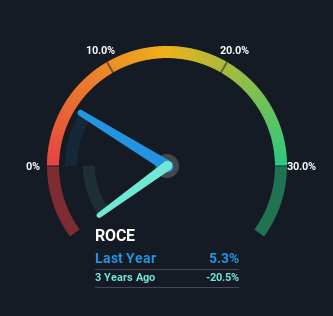- Hong Kong
- /
- Oil and Gas
- /
- SEHK:353
Energy International Investments Holdings (HKG:353) Might Have The Makings Of A Multi-Bagger

If we want to find a potential multi-bagger, often there are underlying trends that can provide clues. In a perfect world, we'd like to see a company investing more capital into its business and ideally the returns earned from that capital are also increasing. Basically this means that a company has profitable initiatives that it can continue to reinvest in, which is a trait of a compounding machine. Speaking of which, we noticed some great changes in Energy International Investments Holdings' (HKG:353) returns on capital, so let's have a look.
Return On Capital Employed (ROCE): What is it?
For those who don't know, ROCE is a measure of a company's yearly pre-tax profit (its return), relative to the capital employed in the business. To calculate this metric for Energy International Investments Holdings, this is the formula:
Return on Capital Employed = Earnings Before Interest and Tax (EBIT) ÷ (Total Assets - Current Liabilities)
0.053 = HK$101m ÷ (HK$2.3b - HK$342m) (Based on the trailing twelve months to March 2021).
So, Energy International Investments Holdings has an ROCE of 5.3%. Ultimately, that's a low return and it under-performs the Oil and Gas industry average of 8.9%.
View our latest analysis for Energy International Investments Holdings

Historical performance is a great place to start when researching a stock so above you can see the gauge for Energy International Investments Holdings' ROCE against it's prior returns. If you're interested in investigating Energy International Investments Holdings' past further, check out this free graph of past earnings, revenue and cash flow.
The Trend Of ROCE
We're delighted to see that Energy International Investments Holdings is reaping rewards from its investments and is now generating some pre-tax profits. About five years ago the company was generating losses but things have turned around because it's now earning 5.3% on its capital. And unsurprisingly, like most companies trying to break into the black, Energy International Investments Holdings is utilizing 105% more capital than it was five years ago. We like this trend, because it tells us the company has profitable reinvestment opportunities available to it, and if it continues going forward that can lead to a multi-bagger performance.
On a related note, the company's ratio of current liabilities to total assets has decreased to 15%, which basically reduces it's funding from the likes of short-term creditors or suppliers. Therefore we can rest assured that the growth in ROCE is a result of the business' fundamental improvements, rather than a cooking class featuring this company's books.
In Conclusion...
Long story short, we're delighted to see that Energy International Investments Holdings' reinvestment activities have paid off and the company is now profitable. Although the company may be facing some issues elsewhere since the stock has plunged 79% in the last five years. Regardless, we think the underlying fundamentals warrant this stock for further investigation.
If you want to know some of the risks facing Energy International Investments Holdings we've found 4 warning signs (1 can't be ignored!) that you should be aware of before investing here.
While Energy International Investments Holdings may not currently earn the highest returns, we've compiled a list of companies that currently earn more than 25% return on equity. Check out this free list here.
Valuation is complex, but we're here to simplify it.
Discover if Energy International Investments Holdings might be undervalued or overvalued with our detailed analysis, featuring fair value estimates, potential risks, dividends, insider trades, and its financial condition.
Access Free AnalysisHave feedback on this article? Concerned about the content? Get in touch with us directly. Alternatively, email editorial-team (at) simplywallst.com.
This article by Simply Wall St is general in nature. We provide commentary based on historical data and analyst forecasts only using an unbiased methodology and our articles are not intended to be financial advice. It does not constitute a recommendation to buy or sell any stock, and does not take account of your objectives, or your financial situation. We aim to bring you long-term focused analysis driven by fundamental data. Note that our analysis may not factor in the latest price-sensitive company announcements or qualitative material. Simply Wall St has no position in any stocks mentioned.
About SEHK:353
Energy International Investments Holdings
An investment holding company, engages in the oil production, and oil and liquefied chemical terminal leasing businesses in the People’s Republic of China and Hong Kong.
Solid track record with excellent balance sheet.
Market Insights
Community Narratives




